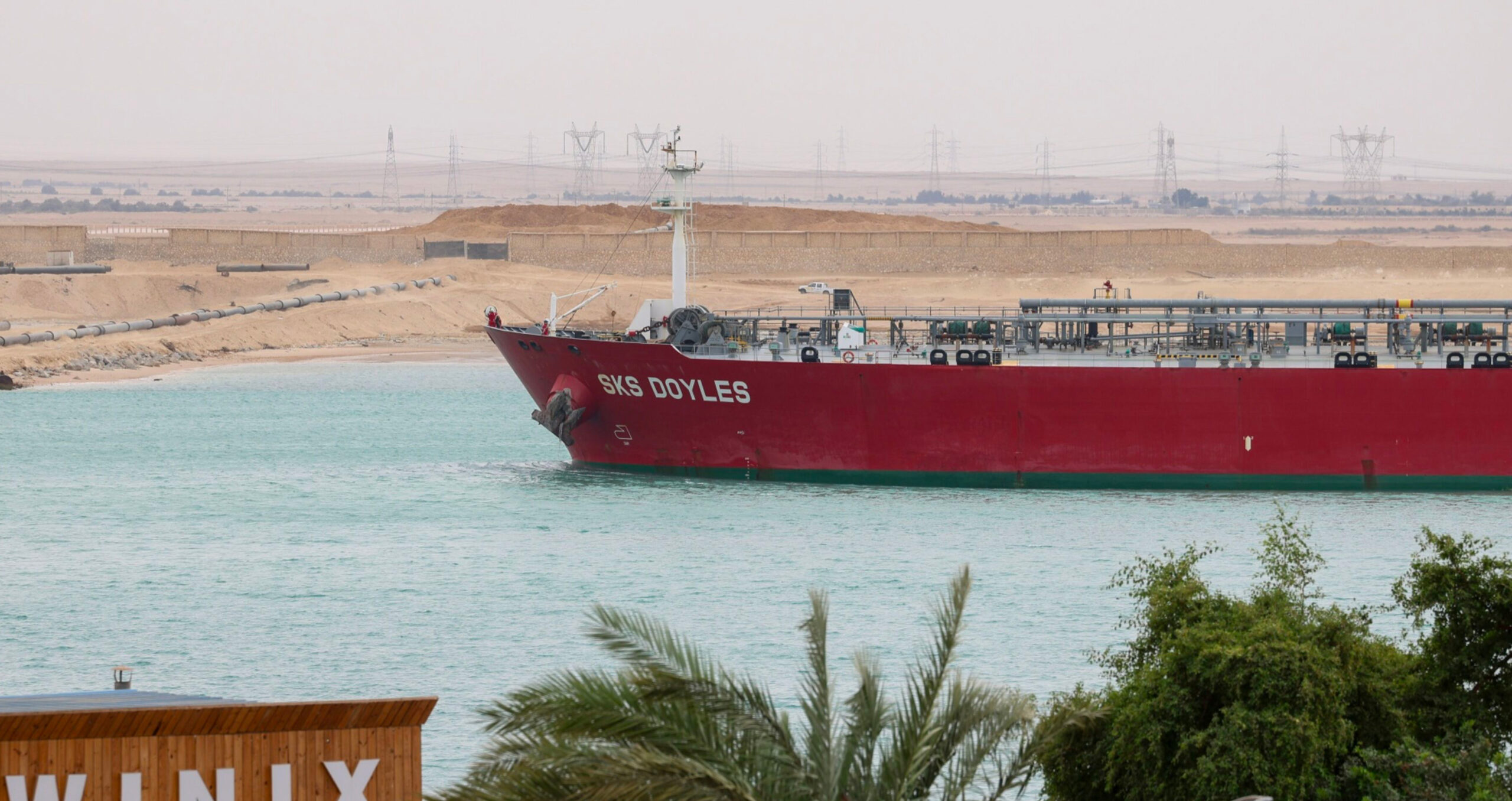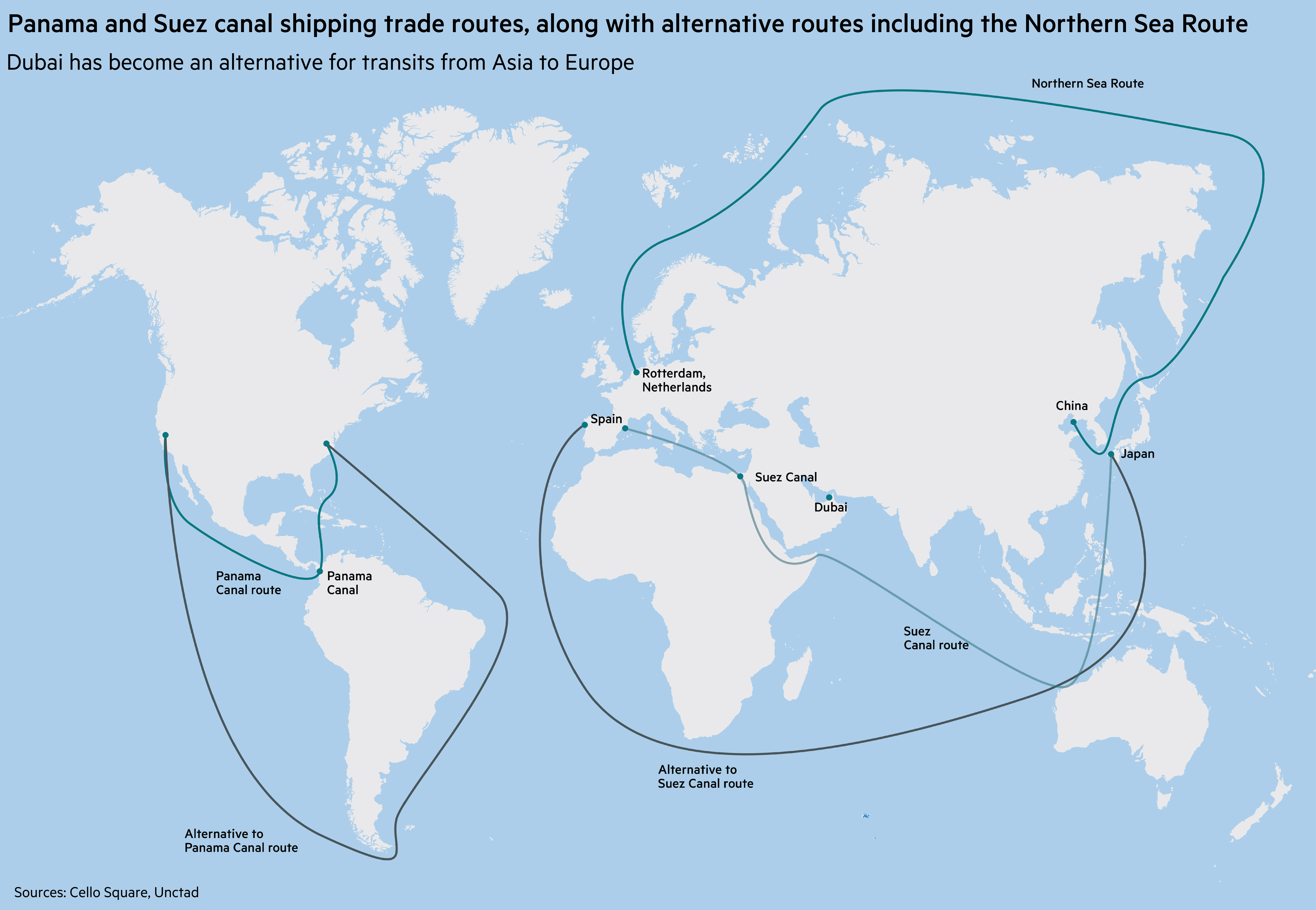
Why trade disruptions are bad news for shipping’s decarbonisation targets

Maritime trade routes continue to be severely restricted, while negotiations on a controversial global shipping levy also resume this week. Experts warn there is no easy solution to either challenge
Some of the world’s most crucial waterways for global trade have been restricted in recent months because of climate impacts and conflict, making journeys by sea longer, more expensive and more carbon intensive.
Since November 2023, attacks on vessels in the Gulf of Aden have disrupted navigation through the Suez Canal, leading many companies to reroute shipping around the Cape of Good Hope. This situation is in addition to existing disruption in the Black Sea caused by the war in Ukraine, which has impacted exports of fossil fuel and grain. Elsewhere, the Panama Canal is experiencing severe drought, resulting in limits being imposed on daily transits.
With maritime transport responsible for delivering 80 per cent of goods worldwide, global trade is facing “unprecedented challenges”, says a report published in February by the UN body for trade and development. Unctad says that, though the combined impact of these overlapping shipping disruptions has not yet reached the level of the supply chain crisis triggered by the Covid-19 pandemic, it is “closely monitoring” the situation.
Countries have unequal exposure
The UN body estimates that transits in both the Suez and the Panama canals are down by more than 40 per cent compared to their peaks. While the decline in the Suez Canal occurred over the past few months, transits through the Panama Canal have been decreasing over the past two years and pose a more persistent problem.
The drought affecting the Panama Canal had forced some vessels to reroute through the Suez Canal, but this is now no longer an option, the UN report points out. It shows that the blockages are having a severe impact on countries’ exports and imports, with some nations being more exposed than others.
For instance, despite the US and China accounting for most of the cargo volume transiting through the Panama Canal, this only represents roughly 12 per cent of US total trade volume and 1.7 per cent of Chinese foreign trade. However, for countries located on the west coast of South America – such as Chile, Peru and Ecuador – the impact on foreign trade is much higher.
Similarly, several African and Middle Eastern countries are highly dependent on the Suez Canal route to trade their goods.
The Unctad report says the combined disruptions are pushing up trade costs, insurance premiums and greenhouse gas emissions as ships are forced to travel longer distances at greater speed to compensate for the diversions while trying to stick to time schedules. It estimates, for example, that vessels’ higher fuel consumption is now adding up to 70 per cent more emissions to a Singapore-Rotterdam round trip.
It stresses that this is a reversal in trend because for more than a decade, the shipping industry had been adopting reduced speeds to lower fuel costs and cut greenhouse gas emissions.
What are the alternatives?
With the accumulation of geopolitical and climate change factors having the potential to alter shipping’s long-established trade routes, finding low-emission alternatives is not easy. “The incentive to decarbonise is not there,” Jan Hoffmann, head of Unctad’s trade facilitation section, tells Sustainable Views.
Despite the industry’s success over the past decade in decreasing the amount of emissions per tonne of trade by improving efficiency on board, emissions have nonetheless continued to increase because global trade has expanded, Hoffmann says.
Moreover, he argues that efficiency improvements have come from economies of scale rather than technological improvements.
With both the Suez and Panama canals partly out of action, rail transport services from Californian ports into the rest of the US have seen an uptick, as well as combined sea/air routes from Asia to Europe.
Dubai has become an alternative for transits from Asia. Cargo ships carrying goods from Asia stop in the most populous city in the United Arab Emirates before continuing their journey by air, instead of navigating through the Suez Canal.
However, this alternative is more expensive, produces higher emissions and has a cost impact on the end-consumer. Prior to the vessel attacks in the Gulf of Aden, the cost of sending products by air was about £1.1 a kilo. That figure has reached £2.65 a kilo, say R. Sri Ram and Smruti Sriram, founders of reusable bag manufacturer Supreme Creations, a family business with its headquarters in London and manufacturing operations in India.
“Increase in logistics costs always hit consumers,” they add. Prior to the disruption, the company sent 70 per cent of its goods by sea, and 30 per cent by air. Today, all deliveries have switched to a sea/air combined method.
Besides the Dubai route, Sri Ram says other destinations, such as Kuwait or Bahrain, could also potentially work as air connections to Europe. He also points out that air cargo volumes have increased so much in Europe that airports are suffering from backlogs, adding another extra cost.
Unctad’s Hoffmann cautions that even moving a tiny proportion of cargo from ship to air in the longer term would be bad for climate reduction targets, since air transport emits more emissions per tonne than shipping. While exact estimates differ, air freight can be up to 50 times more polluting than delivering goods by sea.
Another potential alternative would be to open up the Northern Sea route, where distances are shorter but vessels would have to go much slower and rely on Russian ice breakers to navigate a frozen route because of the colder climate.
“In the end, there’s not much potential for that route to serve the container trade between China and Rotterdam,” says Hoffmann. He adds that, despite evidence that Russian commodities have been shipped using the Northern Sea route, the current geopolitical situation would not make this a valuable alternative to Suez.

Shipping levy talks resume
The shipping industry is facing big questions about how it intends to cut emissions in an economic context that does not provide favourable dynamics to do so.
This week, talks resume at the UN’s International Maritime Organization in London on the potential implementation of a shipping levy.
In the summer of 2023, the IMO agreed to a revised strategy to cut annual greenhouse gas emissions from shipping to at least 20 per cent – striving for 30 per cent – by 2030; followed by a reduction of at least 70 per cent – striving for 80 per cent – by 2040, both in comparison to 2008 levels.
The strategy is underpinned by the development of a green fuel standard to reduce marine fuels’ greenhouse gas intensity over time, and a greenhouse gas emissions pricing mechanism. Agreement on how these two measures will be constructed and implemented is still to be reached, however. Countries will be negotiating different proposals submitted to the discussions taking place over the next two weeks.
Experts following the situation say the most progressive proposal on a pricing mechanism has come from a group of Pacific and Caribbean island states, which has put a price of $150 a tonne of greenhouse gas emitted. Revenues raised would assist low-income countries in adapting to the energy transition, and partly compensate countries facing higher transportation costs as a result of the mechanism.
“The only way to help smaller countries with their shipping routes is to invest in infrastructure, digital solutions and adaptation,” says Unctad’s Hoffmann, who considers a levy solution necessary to making alternative fuels competitive.
Conflict and climate change impacts are an “unsurprising backdrop” to the timeline of decarbonisation, says one of the experts attending the IMO meetings, who spoke on condition of anonymity.
While the sector has been slow compared to others in mobilising itself for a green transition, regulation targeting the maritime industry has started gaining momentum with the EU including shipping in its emissions trading system and passing legislation to curb the emissions intensity of the energy used on board. This law should, in turn, stimulate the use of low carbon fuels although it is yet unclear which alternatives will replace fossil fuels on ships in the long term.
Experts also warn that with the industry facing higher scrutiny, climate litigation risks are also increasing. Whether it is permitting decisions, greenwashing or investment rules, the entire ecosystem of shipping – from cruise companies to charterers, port authorities to insurers and investors – is becoming more vulnerable to legal challenges.
Similar Articles

SDGs remain off track and underfunded

Expanding UK ETS to cover heating and road transport fuels could cut domestic emissions by a quarter


